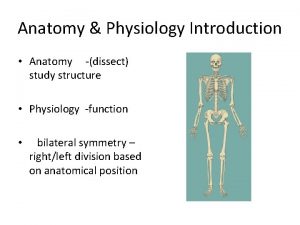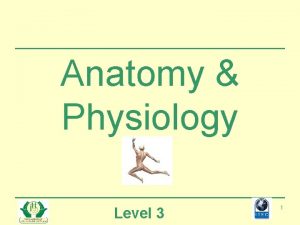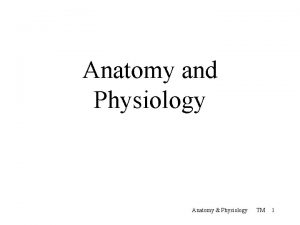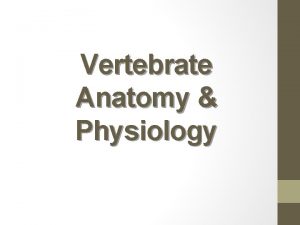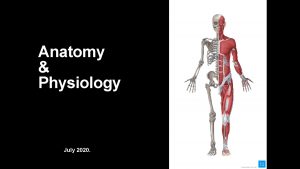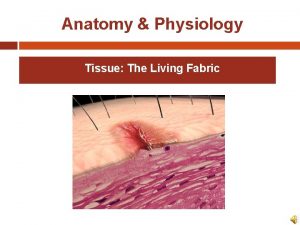Chapter 1 Introduction to Anatomy and Physiology Anatomy




















- Slides: 20

Chapter 1 Introduction to Anatomy and Physiology

Anatomy and Physiology Anatomy – study of structure Physiology – study of function Structure is always related to function

Levels of Organization Atom – hydrogen atom, lithium atom Molecule – water molecule, glucose molecule Macromolecule – protein molecule, DNA molecule Organelle – mitochondrion, Golgi apparatus Cell – muscle cell, nerve cell Tissue – loose connective tissue, muscle tissue Organ – skin, femur Organ System – skeletal system, digestive system Organism - human

Levels of Organization Figure 1. 3—page 5

Characteristics of Life Movement – change in position; motion Responsiveness – reaction to a change Growth – increase in size Reproduction – production of new organisms and new cells Respiration – obtaining oxygen; removing carbon dioxide; releasing energy from foods

Characteristics of Life Digestion – breakdown of food substances Absorption – passage of substances through membranes and into body fluids Circulation – movement of substances in body fluids Assimilation – changing of absorbed substances into different substances Excretion – removal of wastes

Requirements of Organisms Water - most abundant substance in body - required for metabolic processes - required for transport - regulates body temperature Food - supply energy - supply raw materials

Requirements of Organisms Oxygen - one-fifth of air - used to release energy from nutrients Heat - form of energy - partly controls rate of metabolic reactions Pressure - atmospheric pressure – important for breathing - hydrostatic pressure – keeps blood flowing

Homeostasis Body’s maintenance of a stable internal environment Homeostatic Mechanisms – monitor aspects of the internal environment and corrects any changes • Receptors - provide information • Control center - tells what a particular value should be • Effectors - causes responses to change internal environment

Homeostatic Mechanisms Figures 1. 7 and 1. 8—pg. 11 1 -11

Body Cavities Figure 1. 9—pg. 13

Serous Membranes Visceral layer – covers an organ Parietal layer – lines a cavity or body wall Thoracic Membranes • Visceral pleura • Parietal pleura • Visceral pericardium • Parietal pericardium Abdominopelvic Membranes • Visceral peritoneum • Parietal peritoneum

Serous Membranes Figures 1. 11 & 1. 12—pg. 15

Organ Systems

Organ Systems

Organ Systems

Anatomical Terminology Anatomical Position – body standing erect, facing forward, upper limbs at the sides, palms facing forward Terms of Relative Position—pg. 21 • Superior versus Inferior • Anterior versus Posterior • Medial versus Lateral • Ipsilateral versus Contralateral • Proximal versus Distal • Superficial versus Deep

Body Sections • Sagittal / Midsagittal or Median • Transverse / Cross • Coronal or Frontal Figures 1. 20 & 1. 21—pg. 22 • Oblique

Abdominal Subdivisions Figure 1. 23—pg. 23

Body Regions Figure 1. 24—pg. 24 1 -21
 Waistline
Waistline Medial and lateral
Medial and lateral Olecranal region
Olecranal region The central sulcus divides which two lobes? (figure 14-13)
The central sulcus divides which two lobes? (figure 14-13) Anatomy and physiology chapter 8 special senses
Anatomy and physiology chapter 8 special senses Chapter 13 anatomy and physiology of pregnancy
Chapter 13 anatomy and physiology of pregnancy Chapter 2 basic chemistry anatomy and physiology
Chapter 2 basic chemistry anatomy and physiology Chapter 7:9 lymphatic system
Chapter 7:9 lymphatic system Anatomy and physiology coloring workbook chapter 14
Anatomy and physiology coloring workbook chapter 14 Chapter 10 blood anatomy and physiology
Chapter 10 blood anatomy and physiology Anatomy and physiology chapter 15
Anatomy and physiology chapter 15 Necessary life functions anatomy and physiology
Necessary life functions anatomy and physiology Holes anatomy and physiology chapter 1
Holes anatomy and physiology chapter 1 Anatomy and physiology chapter 15
Anatomy and physiology chapter 15 Chapter 2 human reproductive anatomy and physiology
Chapter 2 human reproductive anatomy and physiology Pectoral girdle acetabulum
Pectoral girdle acetabulum Chapter 6 general anatomy and physiology
Chapter 6 general anatomy and physiology The upper respiratory tract
The upper respiratory tract Tattoo anatomy and physiology
Tattoo anatomy and physiology Science olympiad anatomy and physiology
Science olympiad anatomy and physiology Specialized stems examples
Specialized stems examples
























